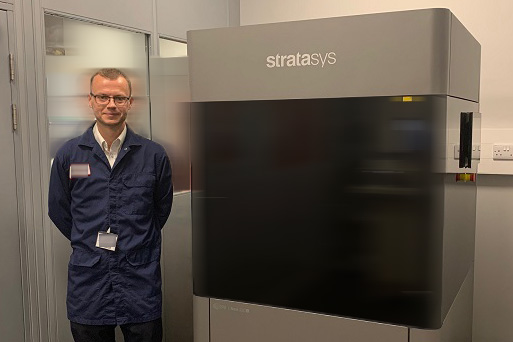National Engineering Day 2022: Stereolithography upgrades

Embracing the latest engineering technologies that help speed up various stages of a product lifecycle is key for an innovative company like MBDA. The use of digital engineering environments makes things quicker and in turn, helps reduce costs. However, there is always a need for physical testing over digital at some point. Traditional manufacturing methods used slowed things down, but the advent of 3D printers that can manufacture parts quickly helps keep things on track and costs from rising.
Investment
At our Bolton site, we have recently invested in one of the latest Stereolithography (also known as SLA) 3D printers, pairing it with the leading software to help with the manufacture of design models, prototypes and finished tooling solutions.
Our Principal Manufacturing Engineer for Stereolithography, Rob, says, “SLA has been in use at MBDA since 1990, but our latest investment is increasing the speed, capability and capacity of our in-house SLA, making this technology even more accessible and allowing greater gains to be realised.”
Increased capability and capacity
Rob says the increase in speed makes the latest printer typically around three times quicker with the same level of fine detail and improved accuracy compared to our existing printer. He adds, “This is due, in part, to the printer’s more powerful and sophisticated dynamic and variable laser beam. Additionally the latest software offers an algorithm-based support generation process that has reduced setup time of complex parts from hours to a few minutes.”
The new printer is not just adding increased speed, but also increased build size, expanding the company’s Stereolithography capability further. Rob goes on to say that the investment is not a replacement, but an addition. “Our existing Stereolithography printer will continue to be used alongside the new one, increasing capacity to the department,” he says.
“Game changing”
Stereolithography is commonly used as a prototyping technology or for concept visualisation parts or models to validate fit form and function. Often engineers will want to test/implement a novel solution. They need an accurate quick 3D mock-up of an idea that everyone can scrutinise.
Rob recounts a recent example where, with the new SLA printer, an engineer was able to merge the housing of a part and a new tooling idea in one large 3D model and get it printed over a weekend for immediate onsite demonstration the following Tuesday. “Using our previous SLA printer only, the model would’ve had to be printed in smaller sections, requiring bonding them together, this would’ve taken a couple of weeks to complete, rather than the couple days the new printer did it all together. Nor would the print have been started immediately due to the workload that preceded it”, he said.
The internal customer in that example, explained a bit more, saying, “A relative portion of a large finished production assembly, was produced using the new SLA Printer, fully utilising its greater foot print capability. The 3D print was mobile and accurate enough to interface with new Tooling at the Suppliers base in the absence of finished production prime equipment that was not available. The time scale to produce was further enhanced by the new SLA printer’s capability. This in all, proved a very useful exercise, deflecting extra time and cost that previously the Business would have had to pick up.
Rob added, “The capability of the new printer is a real game changer for us, it is speeding work up, enabling key decisions to be made quickly, and therefore keeping costs down”
A timely upgrade
The investment and upgrade are timely for Rob and his team. Last year, the department dealt with a new print request, or more, every working day from over 100 internal customers, and this is set to increase. The new printer will help the team meet this increased demand. Whilst any prototype that moves into production in the future falls outside of Rob’s team, the 3D printing is a step on that journey. One that is likely to stay with the benefits it is displaying, more so if the next step is to directly reproduce production parts through additive manufacturing (AM) using the same design specs as tested with the 3D printed prototype.